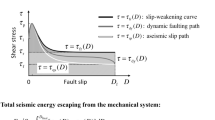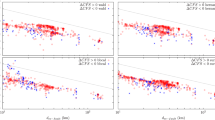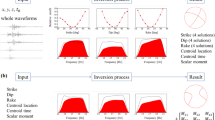Abstract
The relationship between work and energy increment of a thrust fault system with quasi-static deformation can be decomposed into two parts: volume strain energy and deviation stress energy. The relationship between work and energy increment of the deviation stress of a simplified thrust fault system is analyzed based on the catastrophe theory. The research indicates that the characteristics displayed by the fold catastrophe model can appropriately describe the condition of earthquake generation, the evolvement process of main shock of thrust fault earthquake, and some important aftershock properties. The bigger the surrounding press of surrounding rock is, the bigger the maximum principal stress is, the smaller the incidences of the potential thrust fault surface are, and the smaller the ratio between the tangential stiffness of surrounding rock and the slope is, which is at the inflexion point on the softened zone of the fault shearing strength curve. Thus, when earthquake occurrs, the larger the elastic energy releasing amount of surrounding rock is, the bigger the earthquake magnitude is, the larger the half distance of fault dislocation is, and the larger the displacement amplitude of end face of surrounding rock is. Fracturing and expanding the fault rock body and releasing the volume strain energy of surrounding rock during the earthquake can enhance the foregoing effects together.
Similar content being viewed by others
References
Jeger, J. C. and Cook, G. W. Fundamentals of Rock Mechanics, Chapman and Hall Press, London, 466–470 (1979)
Rice, J. R. New perspectives in crack and fault dynamics. Proceedings of the 20th International Congress of Theoretical and Applied Mechanics, Kluwer Academic Publishers, Chicago, 1–23 (2001)
Yin, Y. Q and Zheng, G. T. A cusp type catastrophic model of fault earthquake (in Chinese). Acta Geophysica Sinica, 31(6), 657–664 (1988)
Yong, X. X., Yin, Y. Q., Kang, Z. Y., Liu, G. X., and Wang, T. W. The cusp type catastrophe analyses of compresso-shear fault earthquake (in Chinese). Science China Chemistry, 24(6), 656–663 (1994)
Pan, Y. and Li, A. W. Fold catastrophe model of strike-slip fault earthquake. Applied Mathematics and Mechanics (English Edition), 31(3), 349–362 (2010) DOI 10.1007/s10483-010-0308-9
He, H. L., Sun, Z. M., Wang, S. Y., Wang, J. Q., and Dong, S. P. Rupture of the Ms 8.0 Wenchuan earthquakes (in Chinese). Seismology and Geology, 30(2), 359–362 (2008)
Massimo, C., Concetta, N., and Ekström, G. Static stress changes and fault interaction during the 1997 Umbria-Marche earthquake sequence. Seismology Journal, 4(4), 501–506 (2000)
Ben-Zion, Y. Dynamic rupture in recent models of earthquake faults. Journal of the Mechanicals and Physics of Solids, 49(9), 2209–2244 (2001)
Lin, J. and Stein, R. S. Stress triggering in thrust and subduction earthquakes and stress interaction between the southern San Andreas and nearby thrust and strike-slip faults. Journal of Geophysics Research, 109, B02303 (2004)
Jaime, O. H., Diane, I. D., and Russell, R. Stress changes induced by earthquakes and secular stress accumulation in the Buller Region, South Island, New Zealand (1929–2002). Pure and Applied Geophysics, 162(2), 291–310 (2005)
Kachanov, L. M. Fundamentals of Plastic Theory (in Chinese) (translated by Zhou, H. T.), People’s Education Press, Beijing, 147–148 (1982)
Karcinovic, D. Statistical aspects of the continuous damage theory. International Journal of Solids and Structures, 18(3), 551–562 (1982)
Ling, F. and History, H. Present and advances of the catastrophe theory (in Chinese). Advances in Mechanics, 14(4), 289–403 (1984)
Cook, N. G. W. The failure of rock. International Journal of Rock Mechanics and Mining Sciences, 2(3), 389–403 (1965)
Chen, Y. Mechanical Properties of Crustal Rock (in Chinese), Earthquake Press, Beijing (1988)
Stuart, W. D. Quasi-static earthquakemechanics. Reviews of Geophysics and Space Physics, 17(6), 1115–1120 (1979)
Author information
Authors and Affiliations
Corresponding author
Additional information
Project supported by the National Natural Science Foundation of China (No. 5067059)
Rights and permissions
About this article
Cite this article
Pan, Y., Zhao, Zg. Analysis of main shock of thrust fault earthquake by catastrophe theory. Appl. Math. Mech.-Engl. Ed. 33, 845–864 (2012). https://doi.org/10.1007/s10483-012-1590-8
Received:
Revised:
Published:
Issue Date:
DOI: https://doi.org/10.1007/s10483-012-1590-8
Key words
- thrust fault
- earthquake
- fold catastrophe model
- elastic energy releasing amount
- distance of fault dislocation




